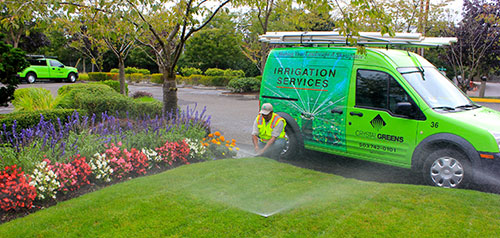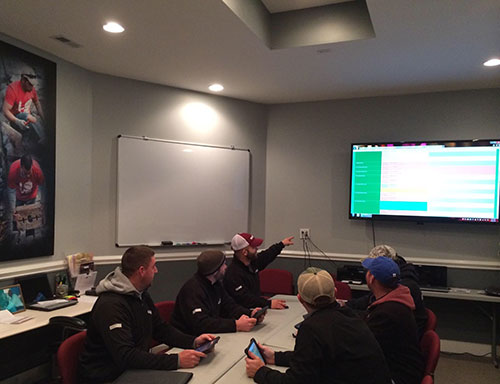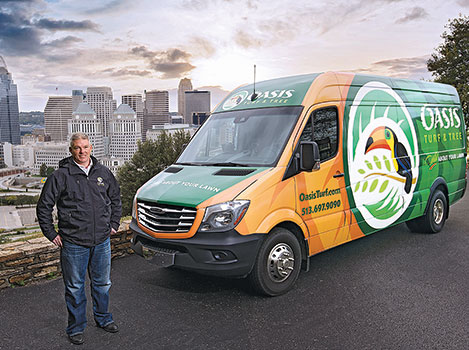Three companies optimize their operations with simple steps and extensive measures.
Driving efficiency

Oasis Turf & Tree, Cincinnati, Ohio
2014 revenue: $3.2 million (+22% over 2013)
Efficiency cred: Three or four technicians will produce more than $300,000 in revenue this year (working nine months).
At Oasis Turf & Tree in Cincinnati most of the company’s efficiency measures are found on the road—namely, in its fleet of 19 Freightliner Sprinter vans with customizations designed in-house. In fact, Oasis was recognized for the vehicles late last year when it won the 2014 “(Up)fit for Success” contest, sponsored by Inc. magazine and Mercedes-Benz Sprinter. The company also made the Inc. 5,000 list of fastest-growing companies last year for its 107 percent growth and 2013 revenue of $2.6 million.
For Oasis, being more efficient means the ability to use higher quality products, says Rob Reindl, president. His company spends more—double, in some cases, he’s been told—on its inputs compared to other lawn care companies.
“To be able to do that, we need to make it up in efficiency if we’re going to be cost competitive,” he says. “It’s all about, ‘What’s the right price for the service so you can be profitable and continue to make an investment in your growth?’”
A primary investment is its fleet of Freightliner Sprinter 3500 Cargo Vans, which Reindl has favored since 2006 when he first began using them.
He went with the vans after phasing out mowing services in 2004 because they were fuel efficient, enclosed with a high roof, you could ride a spreader-sprayer into them and, importantly, they’re customizable.
Key features of the Oasis vans include a folding ramp in the back; custom hooks, shelves and cubbies; a product tank designed in-house that slides in and out for easy repairs and cleaning; an aluminum tank frame that doubles as a waist-high shelf for fertilizer bags and a custom mixing system that limits chemical exposure.
Reindl points out that seemingly little details add up to big savings.
For example, Oasis uses an aluminum, spring-assisted manual ramp. Some companies have a hydraulic ramp that takes 30 seconds to lower and raise at each stop, for a total of one minute. That may not seem like much time, until Reindl explains, “A minute at each stop, times 25 to 30 stops, is an extra half hour added onto each technician’s day.”
Eliminating difficult tasks like hauling bags of fertilizer saves time and prevents worker fatigue. With Oasis’ setup, technicians load fertilizer bags onto the top of their tank frames with a forklift. Then, when they’re on their routes, they pick up the bags at waist height and turn around 2 feet behind them to pour them into the hopper. “There’s almost no movement with the bags,” Reindl says.
The vehicle also includes a mixing system that keeps the water tank separate from the concentrated chemical. A chemical injector called a Dosatron—commonly used by farmers and car wash facilities—dispenses the chemical into the sprayer tank as it’s filled with water.
“There’s very little exposure to chemicals and there’s no mixing,” Reindl says.
He came up with most of the ideas himself, searched for equipment and pieces/parts and then worked with a fabricator to execute the designs.
Not surprisingly, the vans don’t come cheap. One vehicle itself costs about $45,000. With the fabrication, wrap, plus other work done in-house, the total comes in around $60,000.
For Reindl, it pays off in the company’s revenue per hour, which is about $190. The company has three or four technicians who will produce more than $300,000 in revenue this year, working nine months.
Reindl has shown other operators his van design and some have adopted his innovations.
“I’ve also had other friends who’ve looked at our vans and said ‘That’s an incredible waste of money,’” he says. “There’s more than one way to skin a cat. We choose to spend more money on product and provide a superior service.”
Efficiency tip: “You don’t want your guys doing any loading at the beginning of the day. Our technicians have always said: ‘How you get out on that first job really sets the pace for the day. The sooner I get to my first job, the better it seems to go.’”
—Rob Reindl, Oasis Turf & Tree
2-pronged approach

proactive communication, which
its commercial clients value. Photo: Crystal Greens Landscape
Crystal Greens Landscape, Clackamas, Ore.
2014 revenue: $11 million (+120% over 2013)
Efficiency cred: The company improved the amount of time crews spend on-site from 22%-30% to 70%-75%. Its sights are set on 85%.
Crystal Greens Landscape has implemented a host of efficiency-promoting changes over the last four years. Some were by choice and some were by necessity, as the 100 percent commercial maintenance firm ballooned from $2.5 million in 2011 annual revenue to $11 million in 2014. Aside from one acquisition last year, the growth has been organic for the firm founded in 1990 by CEO Pat Murphy.
“It took 21 years for us to reach $2.5 million in revenue and just four to grow from $2.5 million to $11 million,” says Sales Manager Jason Sutton. “There are a lot of moving parts in accomplishing that kind of growth, but one of the major themes has been efficiency.”
The bulk of the gains have come in two areas, he says, helping the company achieve 12 percent profitability.
1. Improving client communications
The leadership team at Crystal Greens, which started in residential maintenance but transitioned to all commercial work by 2000, realized over the last few years that the real difference makers for its property manager clients are response time and proactive communication. It’s not how the grass is mowed or trees are pruned. With that in mind, the company restructured to make account managers its “heroes.”
“They work for our customers directly, and we want everything else in our company to support them,” Sutton says.
For example, supervisors are trained to record and communicate problems, such as dead plant material or landscape damage, to the account manager directly. To do so, supervisors are equipped with smartphones or tablets to take photos/videos of the concerns. Account managers then relay the solution via written proposal to the clients in a timely manner.
The company has created additional expectations to promote account manager/client interaction, such as requiring monthly client calls that are customer-based (and not landscape-based).
“Account managers in our industry historically have had a production approach,” Sutton says. “They say, ‘OK, there are no problems, so why do I need to talk with a property manager? But we’ve tried to stress relationship building.”
It’s all part of an effort to expand relationships beyond company founder Murphy. “He’s as relational as they get, but at some point, he can only manage so many accounts,” Sutton says. Before, the firm had account managers, but only on a production level. Since implementing these changes, Crystal Greens has received good client feedback and has seen referrals rise.
2. Eliminating nonproduction hours
Nothing’s worse than paying people for time that’s not billable, and one major change at Crystal Greens has been to keep that to a minimum. Tactics have included decreasing time spent at the shop and improving routing and density.
At the shop, crews are on the clock at 6:30 a.m. and expected to be on the road by 6:45 a.m. To make this happen, equipment is cleaned and prepped at the end of the work day by a team of three shop workers. They work second shift to assist the company’s three mechanics with servicing equipment, fueling trucks/equipment, sharpening blades and organizing the shop.
Getting a pre-7 a.m. start also has reduced travel time, as crews avoid both a.m. and p.m. rush hours. Adding a few satellite locations also has reduced travel time since there’s less distance between the accounts and home base. “We’ve been able to offer customers more value regarding actual time on-site, doing more detail work and/or offering more competitive pricing,” Sutton says.
Another helpful organizational measure has been splitting the shop between the renovation and maintenance divisions.
“The idea is to take ownership over the equipment rather than saying ‘I can grab whatever I need and go,’” he says. “We track it, so the guys with the least amount of breaks and accidents are rewarded with the newest trucks and equipment.” In turn, the equipment lasts longer and looks better on-site.
Efficiency tip: “We purchased a fuel truck for our facilities. If a four-man crew stops at a gas station for 15 minutes, that’s one hour of labor cost not spent on properties. With 60 trucks, the cost can add up very quickly.”
—Jason Sutton, Crystal Greens
Building a solution

a daily status meeting. Photo: The Loving Group
The Loving Group, Charlotte, N.C.
2014 revenue: $16 million (+60% over 2013)
Efficiency cred: The company produces about $167,000 in revenue per employee.
For The Loving Group (TLG), focusing on efficiency provides structure for growth. “The quicker you grow, the quicker you get off track if you don’t have really defined processes from an efficiency standpoint,” says President Mike Haynes.
He knows a thing or two about growth. He started young, mowing neighbors’ lawns, and then grew his company aggressively after graduating high school in 2004. He began working for national homebuilders in 2009, and the company has surged since then, thanks in part to finding ways to operate optimally.
TLG posted revenue of $4.4 million in 2011, grew to just less than $10 million in 2013 and topped $16 million last year. Haynes is confident the company will grow another 30 percent to 35 percent in 2015, thanks to its internal structure and CloudScape, a software application developed specifically for TLG. The custom program handles inventory and field operations, including scheduling and issuing purchase orders. Combined with the company’s helpdesk, CloudScape is a powerful efficiency tool for TLG.
Haynes was inspired to create a helpdesk about five years ago after seeing it work so well at a company TLG uses for its IT services.
“You were able to get quick responses from people whose job was defined as serving the customer immediately upon contact,” Haynes says. TLG started with one helpdesk staff member and is now up to five people, who are divided among three roles: scheduling expeditor, senior scheduling expeditor and scheduling manager.
Having staff dedicated to customer service, scheduling and ordering frees up field managers to focus on overseeing crews, execution and quality.
Before, field managers scheduled and ordered their own jobs and materials in addition to handling crews, quality and customer relations.
“We were making mistakes,” Haynes says. “We need our field staff managing the field and our office staff managing the office.”
Now, everything goes through the helpdesk to ensure it’s correctly ordered, scheduled and documented via CloudScape.
When it comes to the application, it’s evolved and now has 10 different status levels for every job, so the team can track progress. Haynes estimates CloudScape, which replaced a dry erase board system, has cost $100,000 over about six years.
The program also includes a mobile app for clients to submit work requests and a mobile app for crews. One feature is a site inspection module that’s used every time a crew shows up to a job. Questions include, “Is there damage to the site?” and “Has grading been completed properly?” The crews’ notes are automatically emailed to their field managers to ensure challenges are quickly communicated and properly documented. Crews also take “after” photos before departing jobs. These snapshots are archived on work orders within the application and have saved the company untold dollars by being able to show, for example, what a sod installation looked like the day it was completed.
“We’ve found the blame game has gone down once customers understand there’s a level of documentation on our end, which we believe is a win-win,” Haynes says.
Another useful tool is an automated email that goes to the builder’s superintendent at 7 a.m. on the day the landscape project is scheduled. It prevents crews and materials from showing up at a site that’s not ready, which is wasteful for everyone involved.
“The more efficiently we operate, the more reliable we are and the better partner our customers perceive us to be,” Haynes says. “We really believe the profitability and growth—all of that—comes from one thing: serving our customers.”
Efficiency tip: “Some studies in the builder/landscape industry estimate only 80 percent of billable work is invoiced. We used to allow field staff to take requests on the fly, knowing we were gambling with completed work being properly documented and invoiced. Now, I’m confident 100 percent of our work is invoiced due to the structured process we’ve adopted.”
—Mike Haynes, The Loving Group


